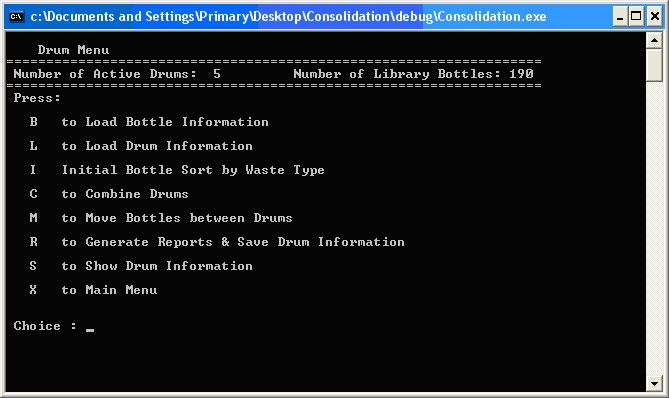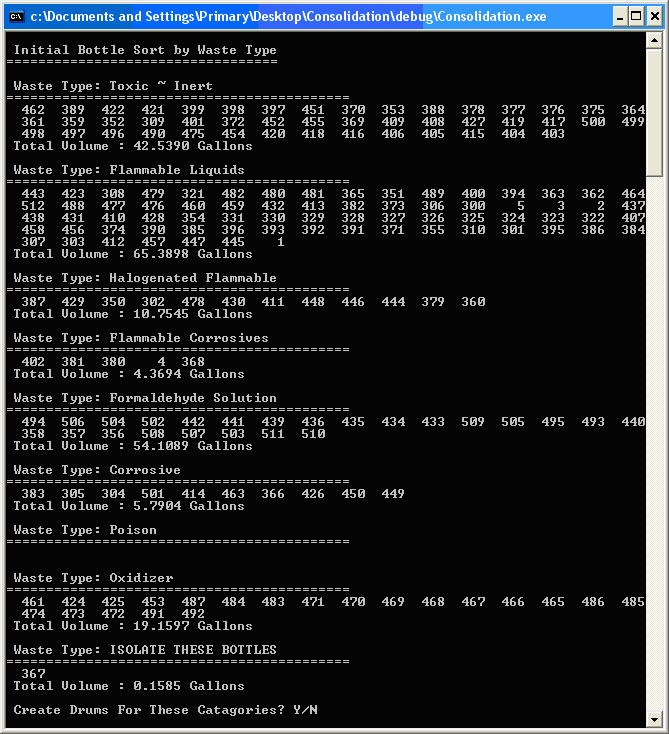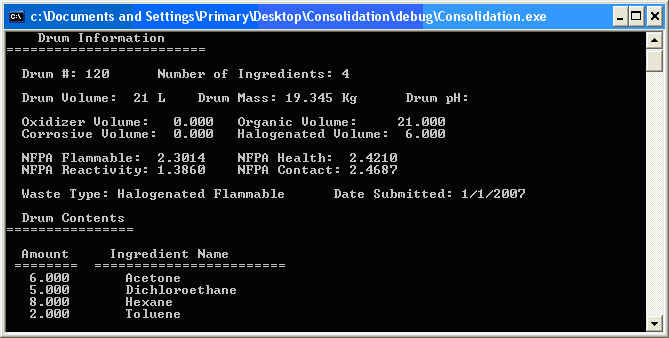|
A Object-Oriented Implementation of a Chemical Waste Consolidation Expert System
Return to front page 1. Background and Rationale 2. Interface Design
3. System Design
4. Evaluation and Results 5. Future Work 6. Conclusions Bibliography and References Appendix A. Example Drum Report Appendix B. Chemical Compatibility Testing Data |
2.3. The Drum Storage Interface
By choosing the Drum Storage Menu option from the Main Menu, the user can access the drum library. This is the final goal of the software: to combine the transport bottles into the drums based on waste type, reactivity and chemical compatibility. This menu has options toLoad Drum Information along with choices to manipulate the bottles into the drums. For user convenience, the Load Bottle Information option was included. Figure 2.13 shows the Drum Menu with the banner to show active drums and bottles. Figure 2.13. The Drum Menu Interface
To begin the consolidation, the Drum Menu choice of Initial Bottle Sort by Waste Type is activated. This routine will sort the bottle library by waste type designation and reactivity. It generates a proposed list of initial drums with the bottles listed in order of increasing reactivity. The calculations to obtain the mixture reactivity are explained in section 3.5. Figure 2.14 demonstrates a listing of sorted bottles. Figure 2.14. The Initial Bottle Sort by Waste Type
The order generated by Initial Bottle Sort is also the program’s suggested order of adding bottles to drums. Adding the lowest reactivity bottle followed by the next lowest and so on is an added safeguard because it adds mass and volume to the drum, which will act as a buffer when more reactive bottles are added [Petrucci 2002]. Finally, the routine asks the user to generate drums to correspond to these catalogs. Pressing Y generates the drums and performs a further compatibility check as it adds the bottles sequentially. In the unlikely event that a similar waste type bottle is incompatible with its companions, the bottle addition transaction is rolled back. The Show Drum Information is very similar to the Show Bottles interface and displays nearly identical data as demonstrated in Figure 2.15. Figure 2.15. The Drum Information Display
The drums can perform functions that the bottles cannot, such as merging drums in the Combine Drums function and migrating individual bottles in Move Bottles Between Drums. Finally, to perform the dissemination of the new waste information, reports are generated by activating theGenerate Reports & Save Drum Information command on the Drum Menu. The original proposal to upload the information to an online database was revised to the generation of local reports for several reasons. Worries about dissemination of this information to the general public, especially after 9/11, would require some level of security. Because computerized and restricted access would prove to be an impediment to the University Police Department and firefighters, information has been requested in the form of printed reports. Another question is the maintenance of the Website and database after the current chemical consolidator leaves his position with the University. The local generation of the reports as text and comma-delineated files is a simple solution to these problems which will allow the reports and data to be distributed in paper or electronic form. The reports detail the current status of all the bulk waste containers and information required to help the University comply with the Environmental Protection Agency’s Resource Conservation and Recovery Act (RCRA) regulations for the operation of a chemical waste storage facility. It tracks the arrival dates, duration of storage, overall volumes and detailed description of the waste. Appendix A shows an example report. |



